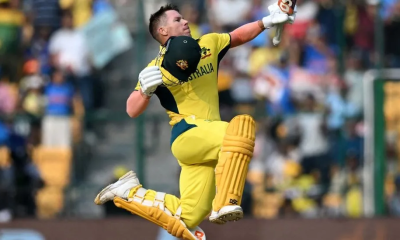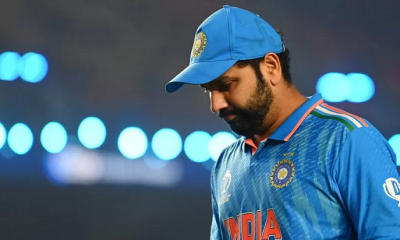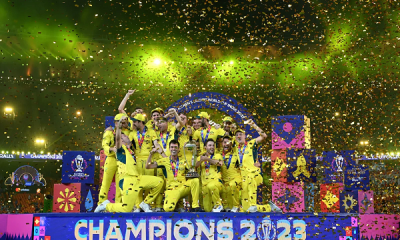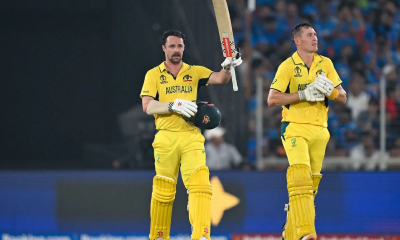Latest News
World Cup head to head: India vs Australia
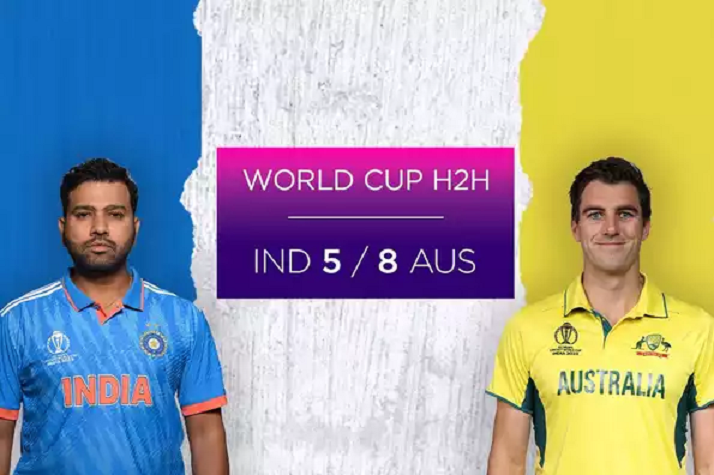
13th June 1983: Trevor Chapell masterclass helps Australia overwhelm India
The first-ever match-up between the two teams came up only in the third edition of the tournament. It was a strange co-incidence that both teams came into the match with underdog status. India’s record in the previous two tournaments was abysmal while Australia themselves were trying to recover during the ‘post-Packer’ phase which had robbed them of several star players. In the era of 60-over games, this match didn’t quite leave up to its billing.
Batting first, Australia rode on the brilliance of Trevor Chappell, who made a fine 110. He was well supported by captain Kim Hughes (52) and Graeme Yallop (66) as they finished with an imposing total of 320 for 9, this despite Kapil Dev coming up with career-best figures of 5 for 43. India were never in the chase and only a swashbuckling 27-ball 40 from Dev saved them from falling to a two-digit score. They were bundled out for 158, losing the contest by a whopping 162-run margin. The highs of beating West Indies and Zimbabwe in the first two matches had come crashing down.
20th June 1983: Binny stars as India gain semis berth
Having been mauled when the two teams met a week back in Nottingham, India extracted sweet revenge with an equally convincing 118-run win at Chelmsford, which also helped them qualify for the semi-finals of the mega tournament. Opting to bat first, India rode on the combined contributions of the entire batting order – with nine batsmen reaching double figures as they posted a respectable 247 on the board, despite being bowled out with 26 balls to spare.
Five batsmen crossed 20, but none could top Yashpal Sharma’s 40. For the bowling side, Rodney Hogg and Jeff Thomson took three wickets each. Chasing 248, Australia collapsed from 46 for 1 to 78 for 7 and with that their hopes of qualifying to the semis were in tatters. Roger Binny was the star performer, finishing with four wickets and so did Madan Lal. India had not only emphatically beaten Australia, but they were through to their maiden World Cup semi-final.
9th October 1987: The Chenauk classic:
One year before the 1987 classic World Cup game between India and Australia, Chepauk had hosted the now famous tied Test. As the defending champions and playing at home for the first time in a World Cup match, India were the obvious favourites, but up against them were the steely Australians. Asked to bat first, the visitors rode on the back of a fine opening partnership worth 110 from David Boon and Geoff Marsh, with the latter going on and scoring a hundred. Dean Jones chipped in with a quick 39 and the eventual total got a two-run boost at the break after India captain, Kapil Dev, acceded to Australian claims that a shot from Jones, which was actually a six was erroneously declared as a four.
India were in no mood to give up though and at one stage were bossing the game, having reached 202 for 2 after 35 overs. The match though turned on its head as Craig McDermott came back to strike four times, his victims being NS Sidhu, Dilip Vengsarkar, Mohammed Azharuddin and Ravi Shastri. The ice cool Steve Waugh then held his nerve to dismiss Maninder Singh in the final over, with India ironically 2 runs short of the target.
22nd October 1987: All-round Azharuddin steers India home
India exacted sweet revenge for their opening Chennai debacle with a comprehensive 56-run win in New Delhi. Asked to bat first by Australia, India found several contributors with Sunil Gavaskar, NS Sidhu and Dilip Vengsarkar, all going past the half-century mark. Mohammed Azharuddin then provided the icing on the cake, making a 45-ball unbeaten 54 as India finished at an imposing 289 for 6. Australia started well in the chase with the iconic opening pair of David Boon and Geoff Marsh adding 88 for the first wicket. But the dismissal of Boon, for 62, derailed the chase and Allan Border’s men never really recovered, despite Steve Waugh’s battling 42. He was one of Azharuddin’s three victims as Australia eventually folded for 233.
1st March 1992: India lose a thriller at the Gabba
The rain rule, under which the 1992 World Cup was played, has had many nodding in disapproval and India became one of its earliest victims, having lost three overs in the chase for just two runs. Rain stopped play with India at 45 for 1 in the 17th over and when play resumed – the original target of 238 from 50 overs was reduced to 236 off 47 overs. Mohammed Azharuddin led a spirited chase, making a fine 93 and Sanjay Manjrekar made a rapid 42-ball 47.
However, both were dismissed run-out and it was left to Kiran More to score the 13 needed off the last over. He cheekily lapped the first two balls from Tom Moody to the long leg fence, but fell while trying to repeat it for a third time. Manoj Prabhakar ran himself out while trying a single off the penultimate ball and it left Javagal Srinath with the task of scoring four runs from the last ball.
The ace Indian pacer hoisted Moody wide of long-on but didn’t have the power to clear the long straight boundaries of Gabba. Steve Waugh, normally the coolest Aussie under pressure, fumbled with the catch, but recovered quickly to throw it back to the keeper – Boon whipped the bails off and found Venkatapathi Raju well short, as he was going back for the match-tying third run. India had lost the match by one run. Earlier, Dean Jones’ sparkling 90 had helped the hosts pile up 237 on the board, despite contrasting figures of 3 for 41 by both Kapil Dev and Manoj Prabhakar.
27th February 1996: Another cliffhanger, another win for Australia
The Wankhede turned up in full force to see an epic clash, to watch legends in action and finally to see Sachin Tendulkar ride India to victory. They got to see a bit of everything, but even a masterclass from Sachin Tendulkar wasn’t enough to give India a win. Batting first, Australia rode on a sensational 126 from Mark Waugh as they posted 258 on the board. When he was the fourth wicket to fall with the score on 232, his team looked poised for a big score, only for India to stage a fine comeback, taking the last six wickets for 26 runs.
The reply started shakily and India were two down in no time. It was then followed by a thrilling counter-attack, as Tendulkar dominated half-century partnerships with both Azharuddin and Manjrekar. It needed a cheeky wide from Mark Waugh to end Tendulkar’s dominance on 90 and that ended India’s fight, despite Manjrekar’s gutsy knock of 62. Eventually, India were bowled out for 242, 16 runs short of the target with Damien Fleming taking 5 for 36.
June 4th 1999: McGarth leaves India done and dusted
India’s chase of a stiff 283 target was all but over in 44 balls. The cream of their batting – which included Sachin Tendulkar, Saurav Ganguly, Rahul Dravid and Mohammed Azharuddin – were back in the hut with only 17 on the board. Ajay Jadeja made a century and Robin Singh chipped in with 75, but the damage had already been done and India fell short by a huge 77-run margin at the Kennington Oval. Asked to bat first under dark skies, Australians were welcomed to the crease by the sun which came out and Mark Waugh ensured that he cashed in on the gift. The elegant right-hander top-scored with 83 and found plenty of support down the order as Australia racked up a massive score on the board.
February 15th 2003: Australia pulverize abject India
An Australia v India World Cup has never been as one-sided as this one. Sample this, India were blown away for just 125, despite Sachin Tendulkar’s 36 and it was chased down with nine wickets and 166 balls to spare. India called correctly and that’s the only thing that went their way in Centurion. Brett Lee and Jason Gillespie took three wickets apiece to cripple India’s middle-order and only Harbhajan Singh’s feisty 28 let India get to the three-figure mark. Adam Gilchrist and Matthew Hayden then added 100 runs for the opening wicket to ensure that the victory was a mere formality.
March 23rd 2003: Ruthless Ponting decimates India
India won the crucial toss in the final of the 2003 World Cup and inexplicably asked Australia to bat first on a placid looking track. Perhaps, the wounds of Centurion hadn’t healed and Ricky Ponting and his team didn’t need a second invitation to make merry. Adam Gilchrist started the run-fest, making a 48-ball 57 and then Ricky Ponting took over. The Australian captain blasted a 121-ball 140*, one of the highlight innings of the tournament and together with Damien Martyn (84-ball 88*) added 234 runs for the third wicket as Australia finished with 359 for two.
The seeds of India’s nervousness were sowed in the first over with Zaheer Khan spraying wides and no-balls in a 15-run over and it ended with boundaries being splattered all over the Bull-ring. India’s chase depended largely on Sachin Tendulkar, but the master’s duel with Glenn McGrath was short-lived, the Aussie speedster sending the maestro back in the first over. Virender Sehwag’s 82 and some rain gave India hope, but they were snuffed up rather quickly as Australia marched to a comprehensive 125-run win at Johannesburg and back-to-back World titles.
24th March 2011: India stop Australia’s title winning run
There was plenty on offer ahead of India’s quarter-final clash against Australia at Ahmedabad. As co-hosts and with a team that never had been that strong, India were one of the perennial favourites and they were up against a team that was gunning for an unprecedented fourth straight world title. Australia were a team that was on the wane, but with the experience of winning three titles on the trot, it was a team that couldn’t be underestimated.
As such a quarter-final clash between two heavyweights was a tad too early in the tournament. Batting first, Ricky Ponting brought back memories of Johannesburg with a well-crafted hundred. Giving him good support was Brad Haddin (53), while David Hussey added the finishing touches with a 26-ball 38.
The target of 261 wasn’t daunting but in a winners-take-all game, it was challenging. Sachin Tendulkar and Gautam Gambhir led the chase with aplomb, but when MS Dhoni was dismissed in the 38th over with the score reading 190, it was left to Yuvraj Singh to guide the team from choppy waters. He found an excellent hand in Suresh Raina and the pair added an unbeaten 72-run stand for the sixth wicket to take India home. The loss ended Australia’s World Cup hegemony and further strengthened India’s position as the leading contender.
26th March 2015: Smith pilots Australia to another World Cup final
Steven Smith took over the controls from Ricky Ponting and India were on a hiding for nothing as they surrendered their defence of the World Cup crown with a massive 95-run loss at the Sydney Cricket Ground. Nothing much went right for the men in blue once they lost the toss. Smith (105) and Aaron Finch (81) added 182 runs for the second wicket and the rest of the order chipped in nicely with useful twenties as the hosts finished at 328 for 7 – a match-winning total in most 50-over contests.
India did stay in the hunt as their openers, Shikhar Dhawan and Rohit Sharma, added 76 runs from 77 balls, but it all went downhill once the pair was broken. MS Dhoni fought a lonely battle with 65, but it was clear that even the normally composed Indian skipper had given up the chase. Eventually, India were bundled out for 233 to bow out of the tournament.
9th June 2019: India produce a statement win
Opting to bat, it was an emphatic batting performance from India at the Kennington Oval. They scored just 41 runs off the first ten overs but ensured that they didn’t lose a single wicket in that phase. That laid the platform for the two-time champions to post a massive total on the board. Shikhar Dhawan top-scored with a terrific ton, Rohit Sharma and Virat Kohli notched up their respective fifties and that was followed by cameos from Haridk Pandya, MS Dhoni and KL Rahul. India finished on 352 for five – the highest-ever World Cup total against Australia.
In reply, the defending champions got off to a cautious start. A mix-up between Aaron Finch and David Warner resulted in the former’s dismissal. Warner and Steve Smith recorded their fifties but they never really threatened to take the game away from their opponents. The arrival of Glenn Maxwell increased Australia’s run-rate as he hit a flurry of boundaries but Bhuvneshwar Kumar pegged them back by dismissing Smith and Marcus Stoinis in the same over. Maxwell perished to Yuzvendra Chahal in the very next over. Alex Carey struck a 25-ball fifty but the Aussies kept losing wickets and ended up falling short of the target by 36 runs with Jasprit Bumrah and Bhuvneshwar picking three wickets apiece.
8th October 2023: Ruthless India start on a winning note
India started their 2023 World Cup hunt at home on the right note with a 6-wicket win over five-time champions Australia at the MA Chidambaram Stadium in Chennai. Pat Cummins won the toss and had no hesitation to bat first. On a slow and dry pitch, India played three spinners and reaped the benefits as they bowled out the Australians for 199. There were a few starts with Steven Smith and David Warner making 40s, but none of the starts were converted into a big score.
Everyone who bowled on that day took wickets for India, with Jasprit Bumrah and Kuldeep Yadav taking 2 each. A 200-run chase should have been straightforward, but India lost Rohit Sharma, Ishan Kishan and Shreyas Iyer, all for ducks as they slipped to 2 for 3. Australia smelt blood and could’ve taken further control had Mitchell Marsh not grassed a simple chance off Virat Kohli, when India’s score read 20. It proved to be a costly miss as Kohli teamed up with KL Rahul to add 164 for the 4th wicket. Rahul’s takedown of Adam Zampa was the talking point going further in the tournament. Kohli fell for 85, but KL Rahul took India past the line, fittingly hitting the winning six to remain unbeaten on 97.
Latest News
‘Bloody policies’: MSF recovers 11 bodies from Mediterranean off Libya

The aid group Doctors Without Borders has reported recovering 11 bodies and rescuing dozens of people off the coast of Libya as it criticised the migration policies of the North African country and European countries.
In a statement on Friday, the group, known by its French initials MSF, said its Geo Barents rescue vessel managed to recover the bodies following a search operation lasting more than nine hours after being alerted by German nongovernmental organisation Sea-Watch, which also rescues refugees and migrants.
“As we cannot determine the reason behind this tragedy, we know that people will continue to take dangerous routes in a desperate attempt to reach safety, and Europe must find safe and legal pathways for them,” MSF said in a post on X. “This catastrophe must end!”
Sea-Watch said it is unclear whether the bodies were victims of a previously unknown shipwreck, adding that they tried to contact Libya’s coastguard to go and retrieve the dead, but received no reply.
“The so-called Libyan coastguard – financed by the EU – ignored our call demanding that the bodies be recovered,” the group said.
Thousands of people trying to head from Africa to Europe use Libya as a departing point, with the Italian island of Lampedusa the nearest European destination as they undertake the dangerous journey across the Mediterranean to escape war, poverty and persecution.
Italy, which wants to put a stop to the migration stream, has said Libya and neighbouring Tunisia must do more to stop people from going to sea. It has also clamped down on the operation of the rescue ships, arguing that they encourage people to head to Europe, a charge that is denied by the charities.
Emphasising its policy on the rescue ships, Italy said on Friday that it forced the MSF rescue vessel to take the 165 people that it had saved from boats in the Mediterranean operation to the northern port of Genoa. The port was more than 650 nautical miles (1,200km) from their position and much farther than the more convenient ports in nearby Sicily, significantly delaying assistance to the rescued.
The route in the central Mediterranean is the most dangerous migrant crossing in the world, with the United Nations registering more than 20,000 deaths and disappearances in the area since 2014.
More than 3,000 refugees and migrants went missing in 2023 while attempting to use the route, according to the International Organization for Migration.
According to Italy’s interior ministry, the number of arrivals in the country has dropped in 2024 to fewer than 21,800 people since the beginning of the year, compared with close to 53,300 in the same period last year.
[Aljazeera]
Latest News
Mustafizur, Rishad, Hridoy dazzle in Bangladesh’s tight two-wicket win over Sri Lanka
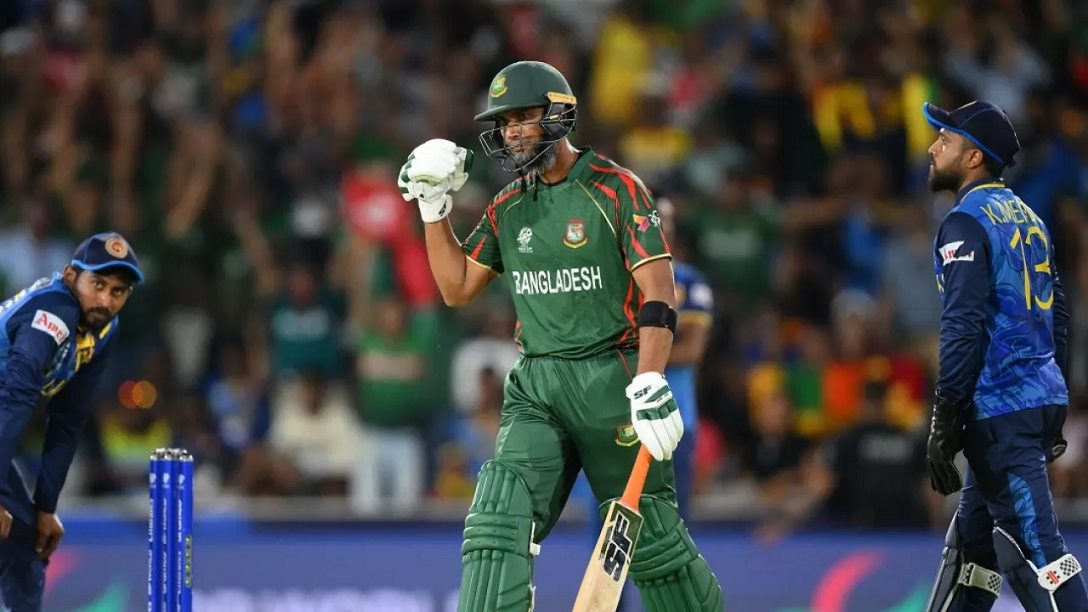
Nuwan Thushara’s last over brought Sri Lanka screaming back into the match,as he first bowled Rishad Hossain, and then nailed Taskin Ahmed in front of the stumps with a pinpoint swinging yorker. This left Bangladesh eight wickets down, with 12 runs still to get.
However, the experienced Mahmudullah was at the crease for Bangladesh, and despite some further nervy moments, pushed Bangladesh across the line off the last ball of the 19th over.
But this was a match chiefly decided by Bangladesh’s own outstanding bowling. Mustafizur Rahman was the best among them, using shorter lengths and his cutters efficiently, to claim figures of 3 for 17. Rishad Hossain’s three-for through the middle overs also kept Sri Lanka quiet.
Mustafizur was instrumental in Sri Lanka’s downward spiral through the middle overs, which culminated in a crash-and-burn end. Ultimately, their inability to find boundaries, or even rotate strike against good Bangladesh bowling resulted in their downfall. A score of 125 for 9 always seemed poor on a decent pitch, even if their bowlers made a match of it in the end.
Brief scores:
Bangladesh 125 for 8 in 19 overs (Towhid Hridoy 40, Litton Das 36; Dhanajaya de Silva 1-11, Nuwan Thushara 4-18, Wanidu Hasaranga 2-32, Matheesha Pathirana 1-27) beat Sri Lanka124 for 9 in 20 overs (Pathum Nissanka 47, Dhananjaya de Silva 21; Tanzim Hasan Sakib 1-24, Taskin Ahmed 2-25, Mustafizur Rahman 3-17, Rishad Hossain 3-22) by two wickets
[Cricinfo]
Latest News
Rashid, Farooqi and Gurbaz the stars as Afghanistan crush New Zealand

Afghanistan boosted their Super Eight chances with yet another dominating win, this time thumping New Zealand by 84 runs in Providence. Having beaten Uganda by 125 runs in their opening match, they are now at the top of Group C with a net run rate of 5.225.
After being sent in, Rahmanullah Gurbaz and Ibrahim Zadran gave Afghanistan a start of 103 in 14.3 overs. It came off the back of the 154 the pair added against Uganda, thus making them the first opening pair to register two successive century stands in the history of the T20 World Cup.
Afghanistan’s was an innings of two halves. They scored 55 for no loss in the first ten overs and 104 for 6 in the last ten, with Gurbaz contributing 80 off 56 balls. New Zealand, who had decided not to play any warm-up games, looked every bit rusty as their fielders dropped catches and missed run-out opportunities.
With the pitch assisting both seamers and spinners, chasing 160 was not going to be easy. But few would have expected New Zealand to collapse in the manner they did.
Fazalhaq Farooqi picked up three wickets in the powerplay and Rashid Khan three just after it. Eventually, both ended with identical figures of 4 for 17 as New Zealand were bowled out for 75 in the 15.2 overs. Glenn Phillips and Matt Henry were the only New Zealand batters to reach the double digits.
Trent Boult found some swing in the opening over but Gurbaz and Ibrahim showed their intent by picking up three fours off Henry from the other end. Both batters had luck on their side, too. Gurbaz got a second life when he skipped down the track to Santner and missed the ball, which went on to brush the leg stump but the bails did not budge. In the following over, Finn Allen dropped Ibrahim off Henry at the deep-square-leg boundary.
That was not all. Gurbaz got another reprieve after being involved in a miscommunication with Ibrahim. Having taken off for a single, Gurbaz had to retrace his steps and would have been run out had Conway not fumbled the throw.
Two balls later, New Zealand finally seemed to have found success when Santner pinged Ibrahim’s pads and umpire Kumar Dharmasena ruled it lbw. But the batter got the decision overturned on review as the ball was heading down the leg side. Immediately after that, Ibrahim hit Santner for an inside-out four as Afghanistan ended the powerplay on 44 for no loss.
New Zealand went against the prevailing wisdom of not bowling an offspinner when two right-hand batters at the crease, and Michael Bracewell repaid that faith by conceding only six off his first two overs.
Lockie Ferguson was even more frugal, going for five in his first two. He could have had Ibrahim off a slower full toss but a leaping Kane Williamson failed to pull off a one-handed stunner at mid-off. That meant while Afghanistan remained unscathed, they had only 55 on the board after ten overs.
Afghanistan had not hit a single six in the first ten overs, but there were five in the next three, including three in one Bracewell over as Gurbaz and Bracewell stepped on the accelerator. The pair took the side past 100 in the 14th over. New Zealand finally broke through when Ibrahim bottom-edged a short ball from Henry onto his stumps, after having been hit on the grille on the previous delivery.
Promoted to No. 3, Azmatullah Omarzai played his part with 22 off 13, which included two sixes in three balls off Henry. Mohammad Nabi fell for a first-ball duck but Gurbaz kept finding the boundary at regular intervals. However, a three-wicket, three-run final over by Boult kept Afghanistan to 159.
Farooqi gave Afghanistan a dream start with the ball. With the very first delivery of the innings, he uprooted Finn Allen’s leg stump as the ball moved in late. In the seamer’s next over, Conway pushed at one that seemed to come slower off the surface and was caught at extra cover.
The decision to give Farooqi a third over in the powerplay brought further rewards. This time, bowling around the wicket to Daryl Mitchell, he got a length delivery to just straighten and take the outside edge. Gurbaz took a regulation catch to complete the dismissal and leave New Zealand 28 for 3.
It could have been worse for New Zealand. In between, Naveen-ul-Haq had rapped Kane Williamson’s front pad after the batter had moved across to play a delivery. Afghanistan sent it upstairs for an lbw review but the umpire’s call saved the New Zealand captain.
Afghanistan did not have to wait too long for Williamson’s wicket. Rashid brought himself on after the powerplay and struck straightaway as Williamson guided one to first slip. But Rashid was just warming up. In his next over, he dismissed Mark Chapman and Bracewell off successive deliveries to leave New Zealand on 43 for 6. Chapman went for a pull and got bowled; Bracewell was late to bring his bat down and was lbw.
Phillips was New Zealand’s last hope. He did hit a couple of boundaries but was soon caught at long-on when he tried to take on Nabi. That ended any hopes of revival New Zealand might have had.
Brief scores:
Afghanistan 159 for 6 in 20 overs (Rahmanullah Gurbaz 80, Ibrahim Zadran 44, Azmatullah Omarzai 22; Trent Boult 2-22, Matt Henry 2-37, Lockie Fergusoan 1-28) beat New Zealand 75 in 15.2 overs (Glenn Phillips 18; Rashid Khan 4 for 17, Fazalhaq Farooqi 4 for 17, Mohammad Nabi 2-16) by 84 runs
[Cricinfo]


